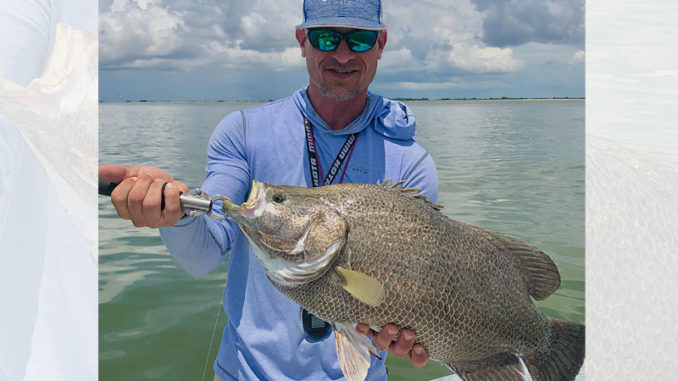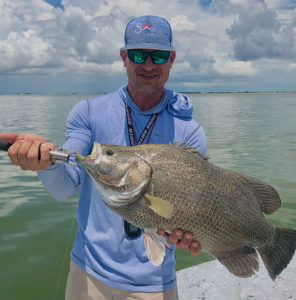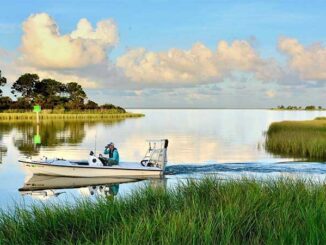
As the mercury continues to rise in the thermometer, new opportunities abound for the avid angler. Although the heat can be stifling, I relish the opportunity to chase after some of the best table fare our local waters have to offer. The coveted and targeted species is the tripletail.
Tripletail get their name from their dorsal and anal fins being set well back toward their tail fin, which give the fish a tri-lobed appearance. They can range from very dark to light brown or bronze in appearance, to mottled. The average fish we catch in southwest Louisiana and southeast Texas is in the 5- to 15-pound range. I like to believe that their flesh is so tender and flaky due to their laziness. Tripletail are frequently mistaken for floating trash, as they are commonly found floating on their sides, just beneath the surface.
We target tripletail by running the beachfront, visually searching for fish. They will frequently stay close to floating structure such as crab-trap buoys, oil-rig legs, debris such as milk jugs, logs, etc. When running the beach or nearshore, I will check for tripletail under anything floating that I run across. Especially check floating debris or seaweed found on rip lines. The clearer the skies and water the easier they are to spot.

I will not specifically go searching for tripletail until the sun has risen a decent amount, usually around 10:30 or so. Fortunately, they are not particularly spooky. Many times, we nearly run one over before spotting it, but they do not go far. After spotting a fish, I kill the big motor and will troll slowly into casting range.
Bait
Tripletail may be willing to hit an artificial lure, but live or dead bait is generally much more effective. Live shrimp, croaker or piggy perch are nearly irresistible to them; however, they will readily eat a dead shrimp if you don’t have live bait. Whether fishing live or dead bait, I will rig it weightless on a Kahle hook. The hook size is dictated by the size of the bait; typically, a 4/0 or 5/0 hook will do. If fishing dead shrimp I definitely prefer to tie on the same hook, but under a cork with about 12 to 15 inches of monofilament leader. Pitch the bait just beyond and in front of the fish, and then reel towards it, presenting the bait where it flutters just in front of the fish’s face. If it does not eat quickly, reel in and cast again.
The only thing better than getting to sight-cast to a tripletail floating peacefully on its side is getting to savor the flavor of its delicate meat. I prefer to dredge the fillet in an egg wash, then batter in a half-and-half mixture of flour and Panko bread crumbs and pan fry in butter. After frying, I top with lump crabmeat and a beurre blanc sauce, and c’est bon!
Capt. Adam Jaynes can be found at justfishsabine.com.
